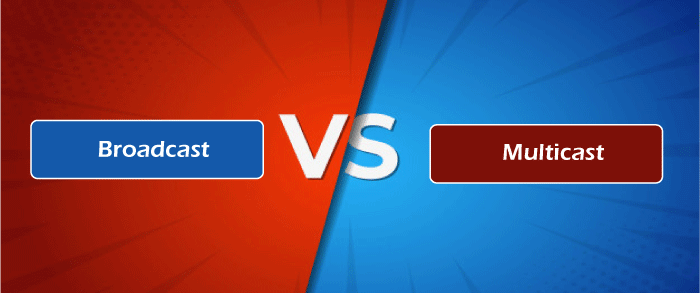Difference between Broadcast and MulticastThe process of delivering data from a source device to a destination device is known as transmission. In a network, data is converted into packets and sent to its destination. There are several methods of transmission, two of which are broadcast and multicast. In summary, multicasting is much more efficient and uses less bandwidth than broadcasting. The transmission technologies broadcast and multicast differ because, in broadcast, the packet is transmitted to all hosts connected to the network. However, the packet is only transmitted to the intended recipients in a multicast. In this article, you will learn about the difference between Broadcast and Multicast. But before discussing the differences, you must know about Broadcast and Multicast. What is broadcast?Broadcast is a transmission mechanism that allows all network hosts to utilize the same communication channel. All other hosts receive a packet transmitted by a host on the network in broadcast mode. This method is also known as "all-to-all". A device on a Local Area Network (LAN) can be configured to broadcast messages to other devices on the network. When a host broadcasts a packet, the intended recipient's address is specified in the packet's address field. Now that the packet has been broadcast, it is received by all other network sites. Each host examines the packet's address field after receiving it. If the packet contains the receiving host's address, it is handled by the receiving host. Otherwise, the packet is disregarded. The broadcast function can address packets to all hosts on the network. To do this, the host transmitting the packet specifies a specific code in the packet's address field. When a packet with a specific code in the address field is sent, it is received and processed by every host in the network. A common example of broadcasting is a wireless network. What is Multicast?Multicasting is the simultaneous transmission of a message or set of packets to several networked devices. Multicasting is secured because only a select group of users receive the packets, and this technique reduces the necessary bandwidth because it distributes a single broadcast among several consumers. The most used protocol for multicasting is called User Datagram Protocol (UDP). Several applications use multicasting. A user may send them to part of the recipients instead of emails to everyone on the contact list. Multicasting is also utilized in webcasts and video conferencing. Additionally, with the use of multicasting, devices like routers and switches deliver packets to a collection of connected devices. Nowadays, multicasting has a variety of applications. For example, assessing a distributed database necessitates multicasting. The information in a distributed database is kept in multiple locations. As a result, the user's information request is broadcast to all database locations, and the site has the intended information answers. Similarly, similar information is distributed to several customers in business, as is news distribution, teleconferencing, and distance learning. Key differences between the Broadcast and Multicast
Here, you will learn the various key differences between Broadcast and Multicast. Various differences between Broadcast and Multicast are as follows:
Head-to-head comparison between the Broadcast and MulticastHere, you will learn the head-to-head comparisons between Broadcast and Multicast. The main differences between Broadcast and Multicast are as follows:
ConclusionThere are two types of transmission: broadcast and multicast. Broadcasting is the process of distributing a packet to every host connected to the system. It is not worth it if each network has thousands of machines. In contrast, multicasting is helpful because it sends the packet to the hosts who are interested in receiving it.
Next TopicDifference between
|
 For Videos Join Our Youtube Channel: Join Now
For Videos Join Our Youtube Channel: Join Now
Feedback
- Send your Feedback to [email protected]
Help Others, Please Share










